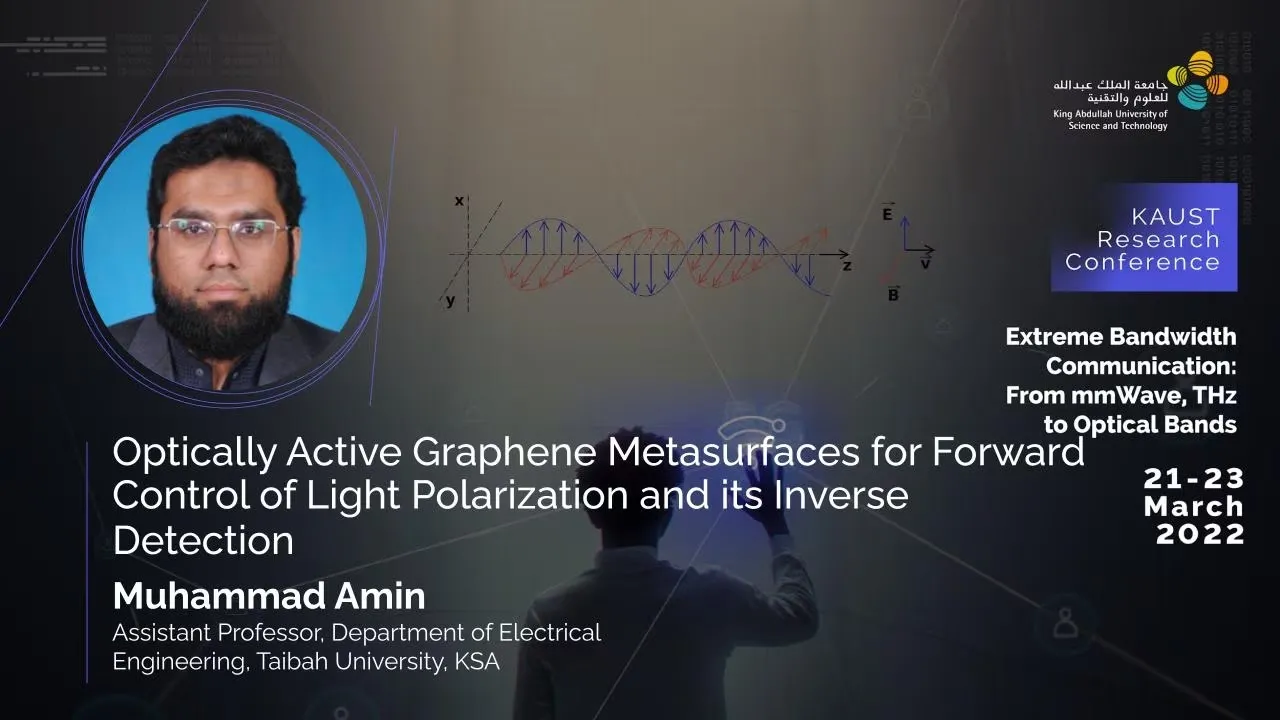
Optically Active Graphene Metasurfaces for Forward Control of Light Polarization and its Inverse Detection
- Muhammad Amin, Assistant Professor, Department of Electrical Engineering, Taibah University, KSA
KAUST Library
Graphene-based ultrathin chiral metasurfaces offer dispersive optical activity in the early terahertz spectrum which results from retarded asymmetrical surface plasmon (SP) currents that are excited by the incident wave. By varying the chemical potential of graphene layer, the associated optical activity spectrum of the linearly polarized incident light waves can be shifted. Consequently, the reflected electromagnetic waves can take linear, circular, or elliptical polarizations depending on the chemical potential. Invoking the reciprocity, when different polarizations impinge the chiral metasurface, different patterns of asymmetric SP currents are formed on the chiral unit cells which can be detected and related to the incident polarizations. This presentation explores ways to exploit the forward control and inverse detection mechanisms of the Graphene-based chiral metasurfaces for telecommunication and biosensing applications. In particular, a unique scheme of polarization-state (PoSK) modulation and a polarization-based virus detection scheme are discussed. Polarization state Keying (PoSK): A dynamically controllable graphene metasurface is capable to switch the polarization state of incident THz waves in real-time. Full-wave simulation results shows that the polarization state modulation with the proposed chiral graphene based metasurface is capable to achieve quaternary modulation for digital communication system. Refractive Index Characterization for Virus Detection: The chirality of the highly sensitive graphene plasmonic metasurfaces can be exploited to characterize complex refractive indexes (RI) of influenza viruses by detecting the polarization state of the reflected electric fields in the THz spectrum. The unique polarization states are observed in the far-field with the ellipticity values that change rapidly with the analyte’s RI. The determination of biomolecular binding event is treated as an inverse problem in which the polarization states of the virus are compared with a pre-calculated calibration model.
Overview
Abstract
Graphene-based ultrathin chiral metasurfaces offer dispersive optical activity in the early terahertz spectrum which results from retarded asymmetrical surface plasmon (SP) currents that are excited by the incident wave. By varying the chemical potential of graphene layer, the associated optical activity spectrum of the linearly polarized incident light waves can be shifted. Consequently, the reflected electromagnetic waves can take linear, circular, or elliptical polarization depending on the chemical potential. Invoking the reciprocity, when different polarizations impinge the chiral metasurface, different patterns of asymmetric SP currents are formed on the chiral unit cells which can be detected and related to the incident polarizations. This presentation explores ways to exploit the forward control and inverse detection mechanisms of the Graphene-based chiral metasurfaces for telecommunication and biosensing applications. In particular, a unique scheme of polarization-state (PoSK) modulation and a polarization-based virus detection scheme are discussed.
Polarization state Keying (PoSK): A dynamically controllable graphene metasurface is capable to switch the polarization state of incident THz waves in real-time. Full-wave simulation results show that the polarization state modulation with the proposed chiral graphene-based metasurface is capable to achieve quaternary modulation for a digital communication system.
Refractive Index Characterization for Virus Detection: The chirality of the highly sensitive graphene plasmonic metasurfaces can be exploited to characterize complex refractive indexes (RI) of influenza viruses by detecting the polarization state of the reflected electric fields in the THz spectrum. The unique polarization states are observed in the far-field with the ellipticity values that change rapidly with the analyte’s RI. The determination of biomolecular binding event is treated as an inverse problem in which the polarization states of the virus are compared with a pre-calculated calibration model.
Brief Biography
Muhammad Amin received the M.Sc. degree in Photonics Program jointly offered by the University of St Andrews, U.K., Heriot Watt University, U.K., and the Royal Institute of Technology (KTH), Sweden, and the Ph.D. degree in electrical engineering from KAUST, Saudi Arabia, in 2014. He is currently faculty member with the Department of Electrical Engineering, Taibah University, Saudi Arabia. His main research interest includes: 1) light-matter interactions at sub-wavelength scale for sensing, energy harvesting applications; 2) realizing high-frequency microwave components such as isolators, diodes, switches, modulators, and all optical buffers; and 3) acoustic materials for sound absorption and ultrasonic imaging applications. He was a recipient of the Erasmus Mundus Scholarship for his M.Sc. degree in Photonics Program, and the King Abdullah Fellowship, Academic Excellence and Provost Awards during his Ph.D. degree.
